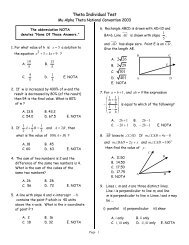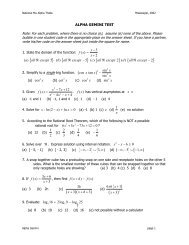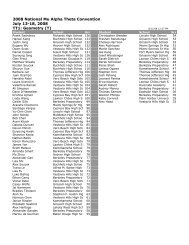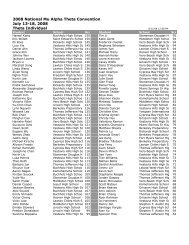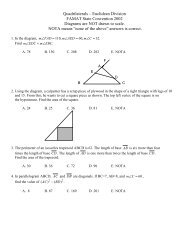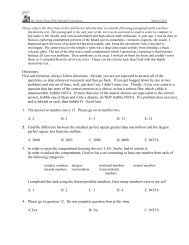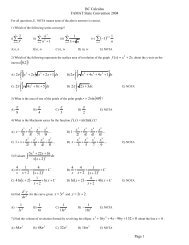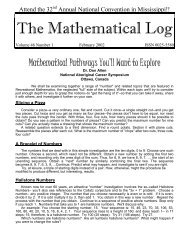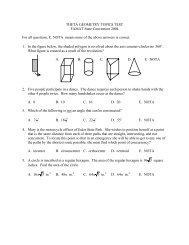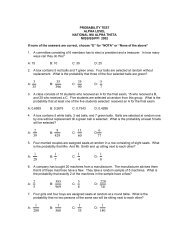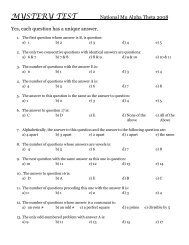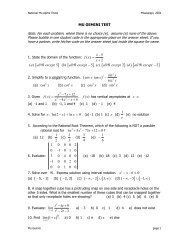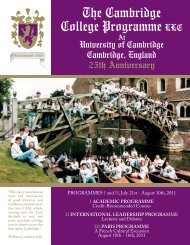Test - Mu Alpha Theta
Test - Mu Alpha Theta
Test - Mu Alpha Theta
You also want an ePaper? Increase the reach of your titles
YUMPU automatically turns print PDFs into web optimized ePapers that Google loves.
<strong>Alpha</strong> Analytic Geometry µαθ National Convention, 2012<br />
Please Note: (E) NOTA denotes none of the above (answers are correct).<br />
1 A unit circle is cut into 2012 pieces (all equal in arc length) by 2012 distinct points. Three<br />
of them are chosen at random. The probability that these three points form a right triangle<br />
is m/n where m and n are relatively prime integers. What is m + n<br />
(A) 673491 (B) 673686 (C) 2014 (D) 2013 (E) NOTA<br />
2 Consider the equation of circle ω given by: (x + 1) 2 + (y + 1) 2 = 1. Let u = ab where the<br />
point (a, b) lies on the circle. Find the sum of the largest and smallest value of u.<br />
(A) 3 + 2 √ 2 (B) 3 2 + √ 2 (C) √ 2 (D) 3 2<br />
(E) NOTA<br />
3 There are two distinct lines tangent to circle ω (see question (3)) which pass through (5, 3).<br />
The larger of the slopes of these two lines can be expressed in the form x+√ y<br />
z<br />
where x, y, z ∈ Z<br />
and where y isn’t divisible by the square of any prime. Find the sum of x, y, and z.<br />
(A) 120 (B) 110 (C) 100 (D) 90 (E) NOTA<br />
4 What is the area of the triangle formed by connecting the points (0, 0, 0), (1, 1, 2), and (3, 4, 2)<br />
(A) √ 61 (B) √ 53 (C) √ 61/2 (D) √ 53/2 (E) NOTA<br />
5 The vectors 〈1, 1〉 and 〈7, k〉 will be orthogonal for which value(s) of k<br />
(A) 7 (B) −7 (C) 7 and −7 (D) −1 (E) NOTA<br />
6 What is the maximum number of regions 2011 lines divide a plane into (you may assume that<br />
all the lines lie in the given plane)<br />
(A) 20112 + 2009<br />
2<br />
(D) 20112 + 2013<br />
2<br />
(B) 2011 2 + 2011 (C) 20112 + 2011<br />
2<br />
(E) NOTA<br />
7 Consider two integers, a and b, which are both randomly chosen from the interval (0, 2012).<br />
What is the probability that the sum of the slopes of the asymptotes of the hyperbola shown<br />
below is zero<br />
(x − b) 2<br />
a 2 − y2<br />
4b 2 = 1<br />
(A) 1/2011 (B) 1/2012 (C)<br />
1<br />
( 2011<br />
2<br />
Page: 1 of 4<br />
) (D)<br />
1<br />
( 2010<br />
2<br />
) (E) NOTA
<strong>Alpha</strong> Analytic Geometry µαθ National Convention, 2012<br />
8 The three points (1, 1), (k, 3), and (2, k) will all lie on a circle except for t (an integer) values<br />
of k. Find the sum of the possible values of k and the value of t.<br />
(A) 4 + √ 2 (B) 4 (C) 2 + √ 2 (D) 1 + √ 2 (E) NOTA<br />
For Questions (9), and (10) let ⃗i = 〈1, 0, 0〉, ⃗j = 〈0, 1, 0〉, and ⃗ k = 〈0, 0, 1〉.<br />
9 Let ⃗u = i × (j × k). What is ||⃗u|| <br />
(A) 0 (B) 1 (C) √ 3 (D) 3 (E) NOTA<br />
10 Let ⃗v = i × (j × (k × (i × (j × k × (i × (j × (j × k))))))). Find ||⃗v||.<br />
(A) 0 (B) 1 (C) √ 3 (D) 3 (E) NOTA<br />
11 Consider the two sets: A = {(x, y) | x 2 + y 2 = 4}, and B = {(x, y) | (x − 3) 2 + (y − 4) 2 = r 2 }.<br />
If the intersection of sets A and B only has one element, what is the sum of the possible<br />
values of r (assuming they are positive)<br />
(A) 3 (B) 4 (C) 7 (D) 10 (E) NOTA<br />
12 By definition, if ⃗a and ⃗ b are vectors, and θ is the angle between then, then ||⃗a× ⃗ b|| is equivalent<br />
to . . .<br />
(A) sin θ (B) cos θ (C) ||⃗a|||| ⃗ b|| cos θ (D) ||⃗a|||| ⃗ b|| sin θ (E) NOTA<br />
13 Let θ be the angle, in degrees, between the two vectors 〈1, 1, 1〉 and 〈2, 4, 3〉. In which of the<br />
following intervals does θ lie NOTE: all intervals are in degrees.<br />
(A) (0, 20) (B) (20, 40) (C) (40, 60) (D) (60, 80) (E) NOTA<br />
14 Consider the plane which passes through the points (1, 2, 1), (0, 3, 1), and (2, 5, 7) What is<br />
the shortest distance between this plane and the point (−1, −2, 2)<br />
(A) 5√ 11<br />
11<br />
(B) 10√ 11<br />
11<br />
(C) 5√ 22<br />
11<br />
(D) 10√ 22<br />
11<br />
(E) NOTA<br />
15 Vectors, ⃗a and ⃗ b are said to be orthogonal if . . . (in the following answer choices, θ is the<br />
smaller angle between the two vectors).<br />
(A) sin θ = 0 (B) cos θ = 0 (C) tan θ = 0<br />
(D) tan θ is undefined (E) NOTA<br />
Page: 2 of 4
<strong>Alpha</strong> Analytic Geometry µαθ National Convention, 2012<br />
16 Find the area of the polar graph: r =<br />
5<br />
3 + 2 cos θ .<br />
(A) 3π √ 5 (B) 3π √ 6 (C) 3π √ 7 (D) 6π √ 2 (E) NOTA<br />
17 What is the eccentricity of the graph of: 2012! · y 2 = 1 (x − 2010!)<br />
2011!<br />
(A) 0 (B) 1 (C) 2012! · 2011! (D)<br />
1<br />
(E) NOTA<br />
2011! · 2012!<br />
18 In a certain ellipse, one of its foci lies at (2012, 2012). If the point (0, 0) is on the graph,<br />
and the ellipse has major axis length 2012 2√ 2, then which of the following might be the<br />
coordinate of the other focus<br />
(A) (2012, −2012) (B) (−2012, 2012) (C) (−2011 2 · 2012 2 , 0)<br />
(D) (2011 2 · 2012 2 · 2, 0) (E) NOTA<br />
19 What is the slope of the line tangent to the circle (x − 2) 2 + (y − 3) 2 = 2 at the point with<br />
x-coordinate 2 and y-value greater than 3<br />
(A) 3 + √ 2 (B) (3 + √ 2)/2 (C) 0 (D) 3 − √ 2 (E) NOTA<br />
20 The polar point ( 2, π 3<br />
)<br />
in rectangular coordinates is . . .<br />
(A) (1, √ 3) (B) ( √ 3, 1) (C) (2, 2 √ 3) (D) (2 √ 3, 2) (E) NOTA<br />
21 How many distinguishable permutations of the words analytic exist<br />
(A) 40, 320 (B) 20, 160 (C) 10, 080 (D) 5040 (E) NOTA<br />
22 The points (1, 1), (5, 3), and (a, b) form an equilateral triangle. Find the minimum value of ab.<br />
(A) −4 − 3 √ 3 (B) −4 √ 3 (C) 3 √ 3 − 4 (D) 1 (E) NOTA<br />
23 What is the angle between the space diagonal of a cube and one of its face diagonals<br />
(A) √ 3/2 (B) √ 6/2 (C) arccos<br />
( √6<br />
2<br />
)<br />
(D) arccos<br />
( √3<br />
2<br />
)<br />
(E) NOTA<br />
Page: 3 of 4
<strong>Alpha</strong> Analytic Geometry µαθ National Convention, 2012<br />
24 Let R be the circumradius and r be the in-radius of a generic triangle ABC. The law of sines<br />
says that:<br />
Which of the following is X<br />
sin A<br />
a<br />
= sin B<br />
b<br />
= sin C<br />
c<br />
= 1 X<br />
(A) R (B) 2R (C) r (D) 2r (E) NOTA<br />
25 Consider the graph f defined parametrically by: x = sin(2t) and y = cos t. What kind of<br />
graph is this<br />
(A) Parabola (B) Circle (C) Ellipse (D) Hyperbola (E) NOTA<br />
26 The area of one of the “petals” on the graph of the rose r = 12 cos(6θ) is 6π. What is the<br />
area of the entire graph<br />
(A) 12π (B) 24π (C) 36π (D) 72π (E) NOTA<br />
27 The circle which passes through the points (1, 1), (0, 2), and (4, 0) can be expressed in the<br />
form x 2 + y 2 + Ax + By + C = 0. Compute ABC.<br />
(A) −1280 (B) −128 (C) 128 (D) 1280 (E) NOTA<br />
28 The solutions to x 3 − 1 = 0, when graphed in the complex plane, form an equilateral triangle.<br />
Find this triangle’s area.<br />
(A) 3 √ 3/4 (B) √ 3/4 (C) 3/4 (D) √ 3 (E) NOTA<br />
29 The graph of ±(x 2 + y 2 ) 3 2 = 2xy is that of a . . .<br />
(A) rose (B) lemniscate (C) cardioid (D) spiral (E) NOTA<br />
30 Suppose the centroid of triangle EF G, where the vertices have coordinates E(1, 1), F (2, 3),<br />
and G(4, 7), is C(m, n). Find the sum m + n.<br />
(A) 9 (B) 17/2 (C) 17/3 (D) 6 (E) NOTA<br />
Page: 4 of 4



